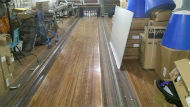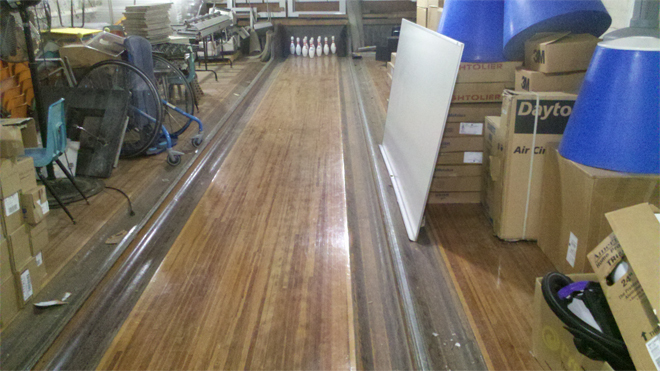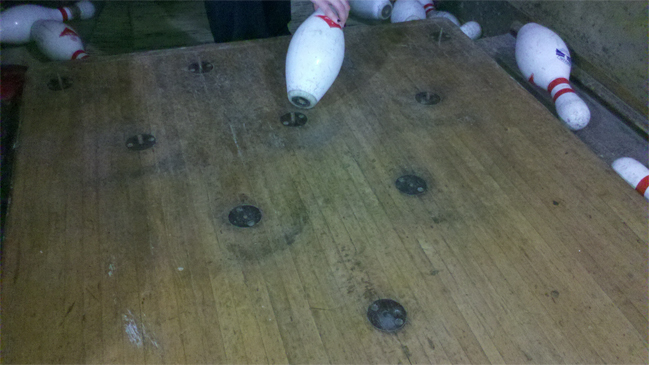73-year-old bowling alley discovered inside school building

 Staff and students at Lakeview Elementary School always knew that history lurked in the building’s basement. They just hadn’t seen it for themselves.
Staff and students at Lakeview Elementary School always knew that history lurked in the building’s basement. They just hadn’t seen it for themselves.
“It definitely has a great mystique up here, especially with the kids,” says superintendant Thomas Manko.
That “mystique” belongs to the bowling alley constructed inside the Mahopac, N.Y. school building’s basement in 1937, when a group of locals scrounged up $50 each to fund the building of four lanes there.
Finally, the bowlers of Mahopac had a place to go.
“Before that, you had to drive to Peekskill or Danbury, Conn. to bowl,” says Donn Tobin, Lakeview’s physical education teacher.
“Back in the 1930s there were no bowling alleys in this immediate area,” explains Trustee of the local historical society, Greg Amato. “A lot of the men liked to bowl and were looking for a place to have some lanes set up.”
For nearly the next 20 years, the lanes they set up in the basement at Lakeview hosted leagues, open play and, of course, gym classes for the students.
Amato, who set pins and bowled there himself as a student at the school in the early 1950s, tells of days when a game of bowling set you back a nickel, pin boys pushed a pedal in the pit to set up another rack as they rolled your ball back on above-ground ball-returns, and you made sure to tip the foul judge who kept his seat in the hallway.
“It’s a narrow room. The room only has enough width to fit the four lanes in it, so they would have a man sitting on a stool in the hallway and he could see if your foot went past the foul line,” Amato explains. “And if someone went past it, he would yell ‘foul!’”
Amato also tells of the day a pin boy working the lanes in that narrow room on Dec. 7, 1941 had a lot more to yell about than fouls in a game of bowling.
“They were having a bowling game there on Dec. 7th, and when word came through about Pearl Harbor, everything came to a halt,” Amato says. “One of the pin boys there ran home to tell his parents what happened.”

But for the past half-century, that history languished under the custodial debris of the storage closet that replaced it. Memories of penciling in your score while the pin boy pushed your ball back lingered only in the minds of those who were there. To everyone else, it was merely the dazzling rumor of a long-gone era.
“For a long time, the kids would say ‘Is it true there’s really a bowling alley down there?’” Lakeview’s principal, Jen Pontillo, says with a chuckle. “And it is true; there really is a bowling alley down there! It just hasn’t been utilized.”
In a town just 50 miles north of New York City, better horizons awaited the bowlers of Mahopac. By the 1950s, the four lanes at Lakeview — then known only as Mahopac Central School — had already outlived their shelf life as bigger, better centers made their way up the Hudson River valley.
The last time anyone had thrown a ball down those lanes before Donn Tobin finally got a look at them last year, Dwight Eisenhower resided in the White House and school basements still doubled as bomb shelters.
“It’s always been known that these lanes were there,” Tobin explains. “It’s just that people haven’t had access to them since 1955 because the custodians use it as a storage closet. People growing up in this town all knew it was here; they heard rumors about it. This is my 14th year teaching physical education here, and I pretty much have been begging for years to get down there. I guess I begged enough that they finally let me in.”
And when they did let Tobin in, it didn’t take long to realize that his dream of revitalizing the lanes for his students faced long odds: a stash of discarded desks and chairs, boxes, lampshades, typewriters and dust had grown over the lanes like moss on a grave.
But if anything is true of Tobin, it’s that someone who spends 14 years begging for a glimpse of that buried history is not easily discouraged. In those overground ball returns and the rusted pedals pin boys once used, Tobin saw opportunity.
“Nowadays, kids don’t keep score; they don’t really know the ins and outs,” Tobin said. “They just know that the ball disappears and some computer gives it back to them.”

Thanks to Tobin’s persistence, principal Pontillo’s approval and superintendant Manko’s help, the students of Lakeview Elementary now enjoy firsthand knowledge of the history that flourished in the basement all those years ago. It turns out there is more to bowling than automatic ball returns and glittering score monitors, after all, and the students of Lakeview Elementary will be the first to tell you.
“We cleared off one of the lanes for use, and we're hoping to clear off a second one," Manko says. "The kids are just as excited as can be. It’s neat to have something like this in your own building, and the students just love being able to pick up the pins and set them up. They have to do it manually, of course, and they love it! They just couldn’t bowl enough, and that’s the kind of excitement you want to see in a physical activity.”
But the school has no plans of stopping there. Staff hopes to reach out to companies throughout the bowling industry in the hope that someone might be able to help refurbish the lanes for further use, and the discovery has attracted the attention of United States Bowling Congress officials.
"I love seeing things like this," says Neil Stremmel, Managing Director of the National Governing Body. "It's a unique situation and a great learning opportunity for the whole industry."
If Lakeview officials have their way, it will be a learning opportunity for students throughout the Mahopac school district as well.
“We’re very interested in renovating the lanes so we can actually incorporate them into our educational curriculum,” Manko explains, “and not just for Lakeview. We’d like to invite children from other gym classes to come on over.”
Lakeview’s principal agrees.
“I am just very excited that we’re using them and I think it was a great idea,” Pontillo says. “Certainly, our hats go off to Mr. Tobin, and I hope it grows. I would certainly like to see it grow.”





